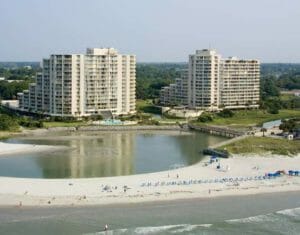Dunes Club Renovation Project Progressing Ahead of Schedule
 The Dunes Golf & Beach Club, Myrtle Beach’s most iconic layout, is undergoing a major renovation project this summer, and the course is progressing ahead of schedule.
The Dunes Golf & Beach Club, Myrtle Beach’s most iconic layout, is undergoing a major renovation project this summer, and the course is progressing ahead of schedule.
The Dunes Club closed on June 4 for the installation of new greens and course enhancements spearheaded by renowned architect Rees Jones.
The installation of Champion ultradwarf bermuda grass greens is the most substantive change, transitioning the course away from bentgrass greens.
Dunes Club tested Champion and MiniVerde bermuda grasses on an alternate green and the chipping area for 2 ½ years, studying how the grasses responded to various climatic factors. After careful evaluation, the Dunes Club, like so many other courses in the South (Pinehurst No. 2 will make the change after next year’s U.S. Open), opted to make the conversion to Champion.
“Bentgrass has been great at the Dunes Club, but it’s so hard to maintain and keep it alive during the summer months,” said Dennis Nicholl, Dunes Club’s head pro. “Ten years ago, we wouldn’t have been having this conversation, but as the new grasses continue to evolve, they are getting better. Bermuda will provide a more consistent putting surface.”
The new greens were sprigged on June 17, allowing 11 weeks to grow-in prior to the course’s scheduled reopening on September 1. Champion only requires eight weeks growth, but the Dunes Club, wanting to assure golfers the quality they’ve come to expect, built in additional time.
The son of the Dunes Club’s architect, Robert Trent Jones, Sr., Rees Jones’ institutional knowledge and affinity for the course made him the natural choice to oversee the project.
“Rees is great,” Nicholl said. “ We wouldn’t have gone anywhere else. We wanted Rees to come in here to keep it consistent with his father’s vision.”
The Dunes Club is increasing the size of driving range by 30 percent and installing new target greens and a new chipping area, enhancing the club’s practice area considerably.
On the course, the only significant change the average golfer will notice is the installation of a new bunker flanking the left side of the first fairway. The bunker will be located 285 yards from the back tee, so it will only come into play for bombers. The bunker will serve as a sightline off the tee for the vast majority of players, helping them aim away from trouble on the right.
“Equipment has outgrown some of our fairway bunkers,” Nicholl said of the impact of space-age driver technology and hot golf balls.
To combat the greater distances, the course, under Jones’ direction, is adding 170 yards of length, stretching the layout to 7,365 yards, a distance that will challenge players at next year’s PGA Professional National Championship.
The increased distance will come via moving several tees back on the front nine. The only hole gaining yardage on the backside is the famed 13th hole. Waterloo, as it’s known, will see it’s championship tee moved back 30 yards, making the dogleg right more daunting for low handicappers.
The Dunes Club’s mission wasn’t only to add distance. Shorter tee boxes are also being added on the third and 13th holes, allowing high handicappers, seniors and some women a greater chance to reach the green in regulation.
Additionally, there were several bunkers on the course that had become to steep over the years, making access – coming and going – difficult for players. Creating softer entrance and exit points is rectifying that problem.
All the of the course’s tee boxes and the collars around the green are being laser leveled, guaranteeing flat surfaces upon reopening, a subtle project that reflects on the club’s commitment to quality.
The Dunes Club, ranked among America’s top 100 public courses by Golf Digest and Golf Magazine, has hosted all three of golf’s major tours. The course was home to the 1962 U.S. Women’s Open, the finals of the PGA Tour’s Q-School, and six senior PGA Tour Championships.



